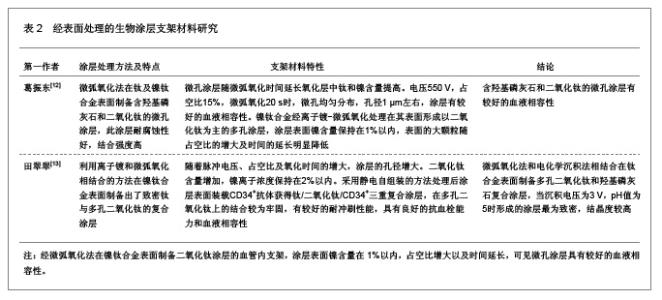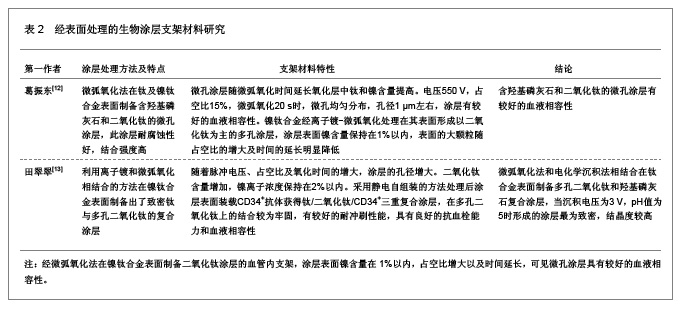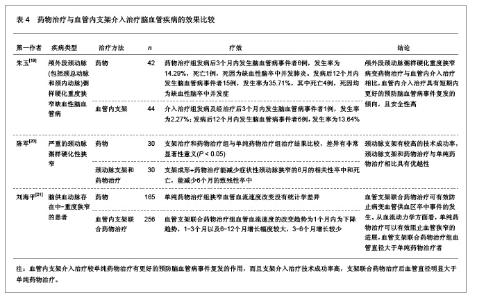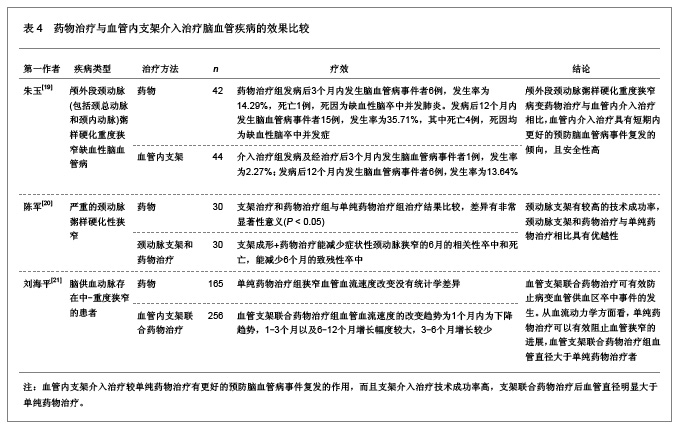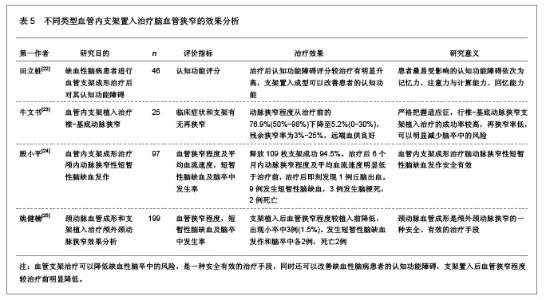Chinese Journal of Tissue Engineering Research ›› 2013, Vol. 17 ›› Issue (12): 2257-2264.doi: 10.3969/j.issn.2095-4344.2013.12.024
Previous Articles Next Articles
Features of endovascular stent materials and their therapeutic effects on ischemic stroke
Guo Yi-tong1, Tan Zhi-gang2
- 1 Sixth Department of Internal Medicine, Ninth People’s Hospital of Shenyang, Shenyang 110024, Liaoning Province, China
2 Department of Emergency, Fengtian Hospital Affiliated to Shenyang Medical College, Shenyang 110024, Liaoning Province, China
-
Received:2012-12-29Revised:2013-02-19Online:2013-03-19Published:2013-03-19 -
Contact:Tan Zhi-gang, Doctor, Chief physician, Master’s supervisor, Department of Emergency, Fengtian Hospital Affiliated to Shenyang Medical College, Shenyang 110024, Liaoning Province, China Tangzhigang5997@163.com -
About author:Guo Yi-tong★, Master, Associate chief physician, Sixth Department of Internal Medicine, Ninth People’s Hospital of Shenyang, Shenyang 110024, Liaoning Province, China
CLC Number:
Cite this article
Guo Yi-tong, Tan Zhi-gang. Features of endovascular stent materials and their therapeutic effects on ischemic stroke[J]. Chinese Journal of Tissue Engineering Research, 2013, 17(12): 2257-2264.
share this article
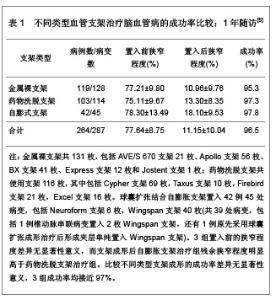
1 血管内支架材料学特征与缺血性脑卒中治疗特点 1.1 资料来源 检索数据库有关血管内支架材料学特点及治疗缺血性脑卒中研究的文献[2],检索时间范围在2003至2012年,检索词为“缺血性脑卒中;血管内支架;支架材料;介入治疗;生物材料”,检索到相关文献120篇,结果分析相关文献24篇[3-26]。 1.2 纳入标准 ①血管内支架材料特点及治疗缺血性脑卒中研究相关的文献。②金属支架材料特征的文献。③涂层支架材料特征的文献。④覆膜支架材料特征的文献。 1.3 排除标准 重复研究、综述或Meta分析类文献。 1.4 分析指标 ①脑血管支架治疗缺血性脑卒中的材料学特征。②涂层血管内支架的材料学特点。③覆膜血管内支架的材料学特点。④血管内支架材料与治疗效果的关系。 1.5 血管内支架的材料学特征 血管内支架按照展开方式可以分为球囊扩张式和自膨式,不同种类的支架适合于不同的血管部位。球囊扩张式支架其自身无弹性,依靠球囊扩张到一定径值后贴附于血管,达到扩张目的,球囊扩张式支架以Palmaz为代表。自膨式支架如Z型支架、网眼状支架等,以Wallstant为代表,可在血管内自行扩张。目前,常用的血管内支架产品有Wallstant、SMART、AVE、BX等。 金属支架在临床治疗中取得了一定的疗效,制作支架的材料有记忆合金、医用不锈钢、钽、钴、镍钛合金等。镁合金材料作为血管内支架,在人体内腐蚀降解成氢氧化镁和氯化镁,并释放氢气,不会对支架附近组织产生毒性反应,但局部组织镁离子和氢气浓度较高时也会有一定影响,目前影响机制还不明确。不锈钢和记忆合金材料与其他金属材料相比,血液相容性相对较好,主要是由于金属材料在血液中长期存放有腐蚀、金属离子溶出和凝血性等问题,再加上合金本身含有镍元素,可能会引起严重的细胞毒性及炎症反应,为解决金属材料存在的不足和弊端问题,可以通过对金属支架进行表面改性来处理,以此来提高金属材料的血液相溶性[3]。 1.6 不同类型血管内支架治疗缺血性脑卒中的成功率 1990 年,Mathias报道临床使用Wallstent支架行颅外颈动脉经皮血管置入治疗颈动脉狭窄,1997年,Higashida报道临床上应用支架置入结合弹簧圈治疗颅内动脉瘤,1998年,开始用心脏冠状动脉支架治疗颅内血管狭窄[4]。近年来,血管内支架得到更为广泛的应用。马明辉[5]研究脑血管支架的材料学特性及其治疗脑血管疾病的应用效果,选取264例脑缺血发作或小卒中患者,置入金属裸支架、药物洗脱支架和自膨式血管支架治疗,分析不同血管支架治疗的成功率,通过长达1年的随访,检查结果见表1。"


药物支架是将治疗药物通过加工涂于支架上制成,使置入到人体内的药物能够持续并高浓度的释放,可以有效的防止支架置入后再狭窄。药物支架的缓释制备方式有几种,一种是直接在支架上涂覆药物,另一种是在可降解的基质材料中放入抗血管增生药,药物释放是通过浓度梯度扩散和支架材料本身的降解来完成,因此称为药物缓释生物可降解支架,此支架制备的难度在于材料的降解速度和抗增生药物速度控制。还有一种方式是药物缓释载体以化学键结合在支架的表面,药物通过与周围环境发生化学和生理作用来释放,这种支架称为药物涂层支架。 由于药物本身大多不能直接黏附于金属支架表面,多数药物支架需要使用缓释涂层。缓释涂层材料要求不仅要具有良好的血液相容性,同时要有恰当的药物缓释曲线,并具有一定的弹性。用于制备药物涂层支架的药品有3种。①血小板功能抑制剂:阿司匹林、苯酚咪唑、潘生丁、抵克力得等。②抗凝血药物:肝素、水蛙素、华法令等。③抗增殖药物:紫杉醇、雷帕霉素等。 雷帕霉素涂层支架是具有控释雷帕霉素的一种大环内酯类抗生素,在细胞周期G1期转折点前中止细胞增殖,具有不杀死细胞而显著抗增殖的特性。具有亲脂性,易通过细胞膜,使局部组织保持较高药物浓度。动物实验显示,雷帕霉素涂层支架较普通支架减少35%-50%的新生内膜,局部炎症反应也明显减轻,几乎不影响新生内膜的细胞成分和内皮化过程,亦未发现中膜局部坏死或内膜出血。药物/基质涂层的表面又覆盖了一层不含治疗药物的纯多聚物保护层,使药物释放的时间进一步延长。药代动力学研究显示,雷帕霉素涂层支架置入后,雷帕霉素峰值浓度为(2.6±0.7) mg/L,仅相当于全身给药时产生免疫抑制作用所需达到的浓度的1/10。置入后3 d时局部组织雷帕霉素水平比血药浓度高35倍,仍有43%的雷帕霉素残留在支架上。因此,既能给局部组织提供足够的治疗药物浓度,又避免由血药浓度过高而引起的全身毒副作用。 石强等[14]研制一种柔顺性与径向张力兼备的颅内专用雷帕霉素药物洗脱支架,科学评估其应用于中枢神经系统的可行性、安全性、有效性,选取2005至2006年症状性大脑中动脉狭窄患者47例,在局麻下采用Seldinger法经股动脉置入动脉鞘后,静脉注射肝素钠3 000-5 000 IU,追加量为2 000 IU/h。多功能导管于病变侧颈内动脉行三维造影,然后行常规全脑血管造影。路径Ⅰ或Ⅱ型且Mori A型采用裸支架置入,路径Ⅲ型或Mori B、C型采用雷帕霉毒药物洗脱支架球囊扩张。直接置入或利用交换法,将导管置入颈内动脉,选择病变展位相,在路图的导引下将0.014微导丝置于大脑中动脉M3或M4段,将快速交换球囊或球扩式支架跨越狭窄段,导引导管内对比,确定支架或球囊的位置。金属裸支架和药物洗脱支架球囊的直径等于或稍小于狭窄远端的正常动脉的直径,球囊的直径为2.0-3.0 mm。用50%浓度对比剂缓慢充盈球囊或球扩式支架,扩张压力小于或等于产品的释放压,缓慢回抽压力泵,再次行导引导管造影,确定残余狭窄率小于20%,撤出球囊。对患者行神经功能评价,10 min后再次造影。立即行头CT平扫,排除出血后,继续肝素抗凝治疗。低分子肝素抗凝3 d。 裸支架置入的21例患者,成功扩张20例,置入前平均狭窄76%,扩张置入后平均狭窄为12%,1例出现严重并发症,血管破裂死亡。雷帕霉毒药物洗脱支架球囊扩张的16例患者中,成功扩张14例,置入前平均狭窄69%,扩张置入后平均狭窄为15%,1例由于路径过度迂曲技术失败。可见,裸支架成形和雷帕霉毒药物洗脱支架球囊扩张法均可有效治疗症状性大脑中动脉狭窄。根据Mori分型和路径分型选择合理术式是降低治疗大脑中动脉狭窄并发症的有效策略。近期随访裸支架成形和雷帕霉毒药物洗脱支架球囊扩张后再狭窄率高仍然是介入治疗中面临的难题。神经功能缺失评分、脑干及大脑组织学检查证实颅内动脉50,100 μg雷帕霉素洗脱支架无神经毒性,洗脱支架内膜化完整,与裸支架组相比抑制血管平滑肌细胞增殖显著,置入后再狭窄明显降低。"

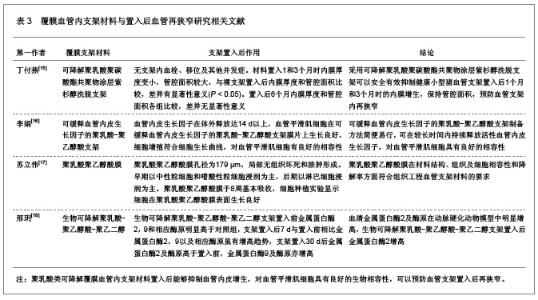
3 覆膜血管内支架的材料学特点 覆膜血管内支架是在金属支架外表覆以可降解或不可降解的聚合物薄膜。聚合物支架是完全由生物可降解的物质化学聚合而成的,主要包括聚乳酸、聚L-乳酸、聚羟基乙酸、聚羟基乙酸-聚乳酸共聚物等。聚合物支架与血管壁的相容性好于金属支架,可避免后期的内膜增殖,特别是可降解的聚合物支架。生物可降解性聚合物所具备的晶体结构、通透性、生物相容性及可伸展性决定了聚合物降解的方式和降解的速率。生物可降解物质仅引起轻微的异物反应,在损伤修复过程中炎症反应轻微,无热原、无溶血、无全身毒性和细胞毒性,其生物相容性更好。覆膜血管内支架材料在心血管疾病治疗中应用相对较多,在修复主动脉夹层、真性主动脉瘤、假性动脉瘤以及主动脉穿透性溃疡等,治疗的成功率较高、创伤小、疗效好。覆膜血管内支架材料在缺血性脑卒中的治疗中也有较多的应用,其置入后血管再狭窄的相关研究文献,见表3。"
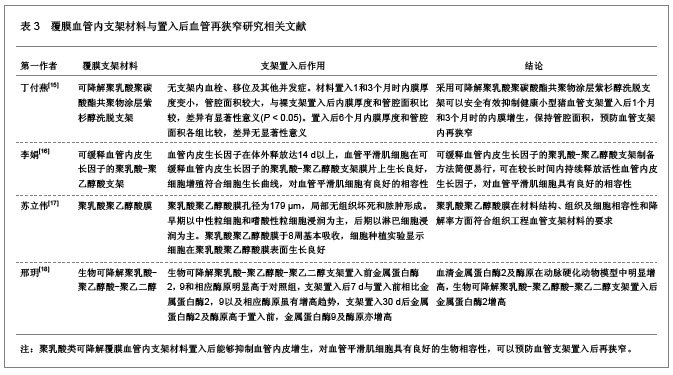

近年来研究发现,血管内放射治疗是预防再狭窄的有效手段之一。射线照射可非选择性的杀死各种引起增殖的细胞,出现射线照射支架用于置入后预防再狭窄的各种方法,临床使用的放射源主要有γ源和β源。目前所采用的放射方法有放射性线源、籽源、放射性液体灌注球囊以及放射性支架置入。放射性线源属于短时照射,要达到既能有效抑制内膜增生,又不对局部组织造成损伤的要求有一定困难,另外,放射性线源或籽源照射存在偏心性,易致局部血管壁受照不均匀,而液体灌注球囊又有破裂的危险。放射性支架属永久置入,射线对血管壁持续照射,作用可贯穿血管损伤后增殖的全过程,产生治疗效果所需的初始活度相当低,对生产、储运及医护人员的操作也都很方便,因而日益受到重视。放射性支架的制备有原子种植法和反应堆轰击法,但有价格昂贵的缺点,而且反应堆轰击还可产生多种不同能量、不同半衰期的放射性物质,成分复杂,限制了其在临床的实际应用。 此外,基因及细胞种植支架,如血管内皮祖细胞种植支架的研究,周振华等[26]研制一种新型血管内皮祖细胞种植支架来防止脑血管介入后的再狭窄,利用密度梯度离心法结合诱导培养法分离纯化脐血源性内皮祖细胞,一种支架表面涂布经碳化二亚胺交联的胶原,另一种涂布经碳化二亚胺交联的胶原后再利用双官能耦联剂N-琥珀酰亚胺基3-(2-吡啶二硫基)丙酸酯与CD34抗体化学键合,再将血管内皮祖细胞进行种植,通过共聚焦显微镜观察其生长状况。发现血管内皮祖细胞能够很好的分离纯化,血管内皮祖细胞种植支架培养7 d后,细胞基本上能够覆盖支架,实现再内皮化,细胞生物学功能良好,并且细胞数量明显多于未种植的细胞支架,抗体耦联胶原方法能有效实现血管内皮祖细胞的种植,防止血管介入后再狭窄。"


5 总结 随着人口老龄化和经济水平的快速发展及生活方式的变化,缺血性脑卒中发病率明显上升,提示以动脉粥样硬化为基础的缺血性脑血管病发病率正在增长。近些年来,随着大量的有关脑血管病二级预防的随机对照试验研究结果的公布,脑血管病的治疗有了充分的证据。2008年,中国制定了缺血性脑卒中和短暂时性脑缺血二级预防指南,提高和规范对脑卒中病因的诊断及危险因素的认识,使医生能够充分利用现有的有循证医学证据的检查手段,对患者进行全面的治疗风险评估及病因诊断,针对不同的病因,并根据危险因素的多寡和严重的程度,对不同复发风险的患者进行分层,制定出具有针对性的个体化的治疗方案。 缺血性脑卒中的危险因素分为可干预与不可干预两类,可干预因素包括年龄、性别、种族、遗传,不可干预因素包括高血压、糖尿病、冠心病、高脂血症、吸烟、肥胖等。缺血性脑卒中的内科治疗主要包括超早期溶栓治疗、抗凝治疗、脑保护治疗、降纤治疗、抗血小板聚集治疗和一般维持生命体征及处理并发症等治疗。药物治疗主要是指寻找和去除危险因子或者是联合使用丙丁酚、阿司匹林或其他抗血小板和他汀类药物。外科治疗主要包括颅动脉架桥、颈动脉和颅内血管内支架成形治疗、球囊扩张成形治疗和脑梗死超早期动脉内溶栓等。缺血性脑血管病的血管支架介入治疗占所有神经介入治疗患者数量的70%,能明确绝大多数脑梗死患者的病因。颈部或颅内血管支架治疗技术,其预后可以使绝大多数患者获满意疗效,脑卒中事件发生危险性明显降低。 良好的血管支架材料应具备以下几方面性质:①具有可控制的生物降解速度。②免疫原性低,不会引起炎症反应。③生物相容性良好。④支架材料的力学和生理学性能良好。⑤还要具备合适的多孔结构。⑥材料易于加工生产。⑦支架在应用前可以消毒[27-29]。 在临床进行血管内支架置入操作时,首先需要行血管造影,明确病变的性质、部位及程度,并选择合适的适应证后,最重要的根据病变特点选择适当的支架,包括支架的类型、直径及长度等指标。支架直径应比病变血管邻近段正常血管直径大10%-15%,支架长度应长于病变。若1个支架或节式不够时,可将2个支架重叠或采用多节式支架。置入支架时应特别注意支架的准确定位,成功的支架置入应使支架准确置于狭窄段,且覆盖病变的上下端,支架置入前后还应注意抗凝治疗,包括服用抗血小板药、抗炎药、生长因子抑制剂和抗细胞增殖药物等,防止血管再狭窄的发生。 作者贡献:郭奕彤进行文章构思、实施及评估,资料收集、成文,郭奕彤对文章进行审校并对文章负责。 利益冲突:课题未涉及任何厂家及相关雇主或其他经济组织直接或间接的经济或利益的赞助。 伦理要求:实验获得所在单位的伦理委员会批注,符合伦理学标准。 作者声明:文章为原创作品,数据准确,内容不涉及泄密,无一稿两投,无抄袭,无内容剽窃,无作者署名争议,无与他人课题以及专利技术的争执,内容真实,文责自负。"

| [1] Dotter CT, Judkins MP. Transluminal treatment of arteriosclerotic obstruction. description of a new technic and a preliminary report of its application.Circulation.1964;30: 654-670.[2] 中国知网.国学术期刊总库[DB/OL].2012-08-10. https://www.cnki.net [3] 赵振心,刘道志,张一.血管支架材料及其临床研究进展[J].中国医疗器械杂志,2005,29(6):391-395.[4] 吴中学.脑血管疾病的支架应用展望[J].中华神经外科杂志,2005, 1(2):65-66.[5] 马明辉.脑血管支架材料学特征及置入后并发症[J].中国组织工程研究与临床康复,2010,14(34):6413-6416.[6] 张孝忠,张晋,张军,等.氮氧化钛涂层支架在老年经桡(尺)动脉冠状动脉血运重建中的应用[J].第四军医大学学报,2008,29(1):3.[7] 邓兴瑞,冷永祥,孙鸿,等.类金刚石薄膜在不锈钢表面结合强度及耐腐蚀性研究[J].功能材料,2009,40(6):1009-1012.[8] 程怀兵.类金刚石薄膜血液相容性及人脐静脉内皮细胞种植实验研究[D].安徽:安徽医科大学,2008:7-9.[9] 邹迪婧,赵红,齐民,等.溶剂对静电纺丝聚氨酯纤维仿生涂层的影响[J].功能材料,2007,38(7):1176-1178,1181.[10] 张丽琨,李钢,杨家声.203枚碳化硅涂层冠状动脉支架-TENAX的临床观察[J].中华心血管病杂志,2003,31(3):210.[11] 孙军,李兴.经皮腔内血管支架成形术治疗颈动脉狭窄的临床体会[J].南通大学学报:医学版,2012,32(3):224-226.[12] 葛振东.钛及镍钛合金表面微弧氧化生物涂层的研究[D].辽宁:大连理工大学,2009:4-5. [13] 田翠翠.钛及镍钛合金表面生物活性涂层的研究[D].辽宁:大连理工大学,2011:4-5.[14] 石强.颅内动脉狭窄的介入治疗及雷帕霉素洗脱支架的动物实验研究[D].辽宁:中国医科大学,2007:6-15.[15] 丁付燕,吕志前,邹榕江,等.聚乳酸聚碳酸酯共聚物涂层紫杉醇洗脱支架预防小型猪血管支架内再狭窄的实验研究[J].中国心血管杂志,2011,16(1):38-43.[16] 李娟.可缓释血管内皮生长因子的聚乳酸一聚乙醇酸支架及与血管平滑肌细胞的细胞相容性研究[D].陕西:第四军医大学, 2008: 6-9.[17] 苏立伟,李霞,赵东锷,等.聚乳酸聚乙醇酸膜、聚β羟基丁酯膜和胶原膜三种材料的相容性探讨[J].中国实验动物学报,2011, 19(3): 255-258.[18] 邢玥,迟宝荣,李淑梅,等.聚乳酸-聚乙醇酸-聚乙二醇血管支架置入对兔动脉粥样硬化模型血清基质金属蛋白酶2,9的影响[J].吉林大学学报,2006,32(2):257-260.[19] 朱玉.颅外段颈动脉粥样硬化重度狭窄病变的药物与血管内介入治疗的比较[D].山东:山东大学,2012:6-8.[20] 陈军.脑保护装置下颈动脉支架成形术治疗症状性颈动脉狭窄可行性研究[D].辽宁:辽宁中医药大学,2011:5-6.[21] 刘海平.药物与支架成形术治疗颅内外血管狭窄的疗效对比[D].吉林:吉林大学,2012:5-7.[22] 田立桩.脑血管支架成形术对缺血性脑病患者认知功能障碍的影响[D].陕西:第四军医大学,2011:6-9.[23] 牛文书,王玉斌,宁群.椎-基底动脉狭窄血管内支架植入25例疗效分析[J].介入放射学杂志,2012,21(7):589-592.[24] 殷小平,夏忠斌,游建友,等.血管内支架成形术治疗颅内动脉狭窄性短暂性脑缺血发作的疗效观察[J].临床神经病学杂志,2011, 24(3):188-190.[25] 姚健楠,刘福全,胡志强,等.颈动脉血管成形和支架植入术治疗颅外颈动脉狭窄[J].中国微侵袭神经外科杂志,2012,17(4): 164-166.[26] 周振华,李露斯,陈康宁,等.血管内皮祖细胞种植支架的研制[J].重庆医学,2008,37(21):2421-2423.[27] Chen G, Ushida T, Tateishi T. Development of biodegradable porous scaffolds for tissue engineering.Materials Science and Engineering C.2001;17(1,2):63-69.[28] Yeong WY, Chua CK, Leong KF, et al.Rapid prototyping in tissue engineering: challenges and potential.Trends Biotechnol. 2004;22(12):643-652.[29] Thomas AC, Campbell GR, Campbell JH. Advances in vascular tissue engineering.Cardiovasc Pathol.2003;12(5): 271-276. |
| [1] | Gu Xia, Zhao Min, Wang Pingyi, Li Yimei, Li Wenhua. Relationship between hypoxia inducible factor 1 alpha and hypoxia signaling pathway [J]. Chinese Journal of Tissue Engineering Research, 2021, 25(8): 1284-1289. |
| [2] | Zhao Min, Feng Liuxiang, Chen Yao, Gu Xia, Wang Pingyi, Li Yimei, Li Wenhua. Exosomes as a disease marker under hypoxic conditions [J]. Chinese Journal of Tissue Engineering Research, 2021, 25(7): 1104-1108. |
| [3] | Li Li, Ma Li. Immobilization of lactase on magnetic chitosan microspheres and its effect on enzymatic properties [J]. Chinese Journal of Tissue Engineering Research, 2021, 25(4): 576-581. |
| [4] | Zhou Anqi, Tang Yufei, Wu Bingfeng, Xiang Lin. Designing of periosteum tissue engineering: combination of generality and individuality [J]. Chinese Journal of Tissue Engineering Research, 2021, 25(22): 3551-3557. |
| [5] | Lang Limin, He Sheng, Jiang Zengyu, Hu Yiyi, Zhang Zhixing, Liang Minqian. Application progress of conductive composite materials in the field of tissue engineering treatment of myocardial infarction [J]. Chinese Journal of Tissue Engineering Research, 2021, 25(22): 3584-3590. |
| [6] | Xie Jian, Su Jiansheng. Advantages and characteristics of electrospun aligned nanofibers as scaffolds for tissue engineering [J]. Chinese Journal of Tissue Engineering Research, 2021, 25(16): 2575-2581. |
| [7] | Ji Qi, Yu Zhengwen, Zhang Jian. Problems and trends of technique and clinical application of metallic biomaterials prepared by three-dimensional printing technology [J]. Chinese Journal of Tissue Engineering Research, 2021, 25(16): 2597-2604. |
| [8] | Qian Nannan, Zhang Qian, Yang Rui, Ao Jun, Zhang Tao. Mesenchymal stem cells in the treatment of spinal cord injury: cell therapy and combination of new drugs and biomaterials [J]. Chinese Journal of Tissue Engineering Research, 2021, 25(13): 2114-2120. |
| [9] | Jia Wei, Zhang Mandong, Chen Weiyi, Wang Chenyan, Guo Yuan. Effects of femoral prosthetic materials on artificial knee arthroplasty performance [J]. Chinese Journal of Tissue Engineering Research, 2021, 25(10): 1477-1481. |
| [10] | Wang Qian, Li Lu, Shu Jingyuan, Dong Zhiheng, Jin Youshi, Wang Qingshan. Micro-morphology and phase of zirconia-based nano-hydroxyapatite functional gradient biomaterials [J]. Chinese Journal of Tissue Engineering Research, 2021, 25(10): 1517-1521. |
| [11] | Li Xiao, Pan Jinbing, Ma Yun, Qian Haoyu, Zhang Quncheng, Wang Zheng. Silicone stent insertion for treating tracheobronchomalacia in adults [J]. Chinese Journal of Tissue Engineering Research, 2020, 24(4): 549-554. |
| [12] | Xie Xiufeng, Zhang Yue, Qu Ze. Clinical outcomes of drug-eluting balloons and drug-eluting stents for the treatment of in-stent restenosis [J]. Chinese Journal of Tissue Engineering Research, 2020, 24(4): 555-560. |
| [13] | Li Li, Ma Li, Li He. Preparation and characterization of magnetic chitosan microspheres [J]. Chinese Journal of Tissue Engineering Research, 2020, 24(4): 577-582. |
| [14] | Tang Mengmeng, Chen Hechun, Xie Hongchen, Zhang Yu, Tan Xiaoshuang, Sun Yixuan, Huang Yina. Histocompatibility of poly(L-lactide-co-ε-caprolactone)/cross-linked polyvinylpyrrolidone ureteral stent grafted into the rat bladder [J]. Chinese Journal of Tissue Engineering Research, 2020, 24(4): 583-588. |
| [15] | Chen Zegang, Ding Haili, Li Long, Wang Chun. Changes of bone metabolism after different intensity endurance exercises in growing rats [J]. Chinese Journal of Tissue Engineering Research, 2020, 24(35): 5582-5588. |
| Viewed | ||||||
|
Full text |
|
|||||
|
Abstract |
|
|||||
